外研版七年级下册英语-语法复习
- 格式:doc
- 大小:57.50 KB
- 文档页数:12
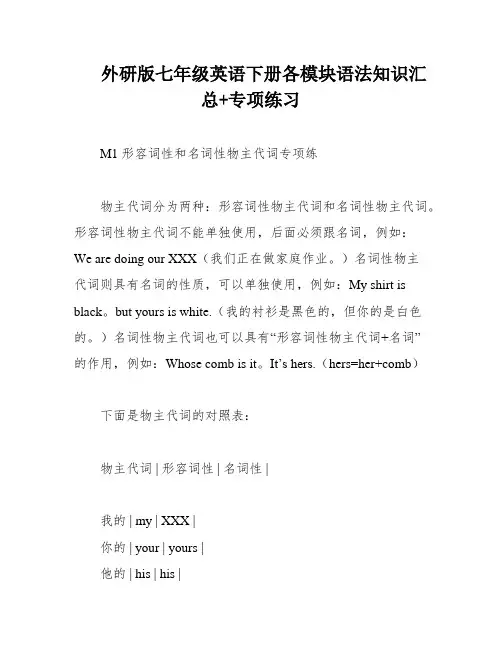
外研版七年级英语下册各模块语法知识汇总+专项练习M1 形容词性和名词性物主代词专项练物主代词分为两种:形容词性物主代词和名词性物主代词。
形容词性物主代词不能单独使用,后面必须跟名词,例如:We are doing our XXX(我们正在做家庭作业。
)名词性物主代词则具有名词的性质,可以单独使用,例如:My shirt is black。
but yours is white.(我的衬衫是黑色的,但你的是白色的。
)名词性物主代词也可以具有“形容词性物主代词+名词”的作用,例如:Whose comb is it。
It’s hers.(hers=her+comb)下面是物主代词的对照表:物主代词 | 形容词性 | 名词性 |我的 | my | XXX |你的 | your | yours |他的 | his | his |她的 | her | hers |它的 | its | its |我们的 | our | ours |你们的 | your | yours |他们的 | their | theirs |需要注意的是,名词性物主代词可指一件东西,也可指很多件东西,需要根据上下文来决定。
例如:选择填空:1.This is my teapot。
It’s not __________。
(your/ yours)2.My hairdryer is on the desk。
Where’s ____________?(her/ hers)3.___________ hairdryer is not on the table。
___________ is there。
(Her/ Mine)4.Whose calculator is it?It’s __________。
It’s __________ XXX)5.Are they ___________ (your/ yours) combs。
Yes。
they’re _________(our/ ours).用所给词的适当形式填空:1.That is not _________ kite。
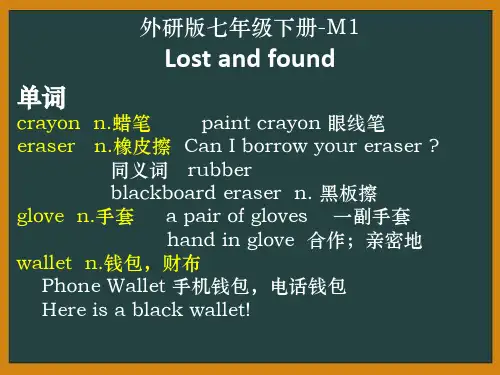
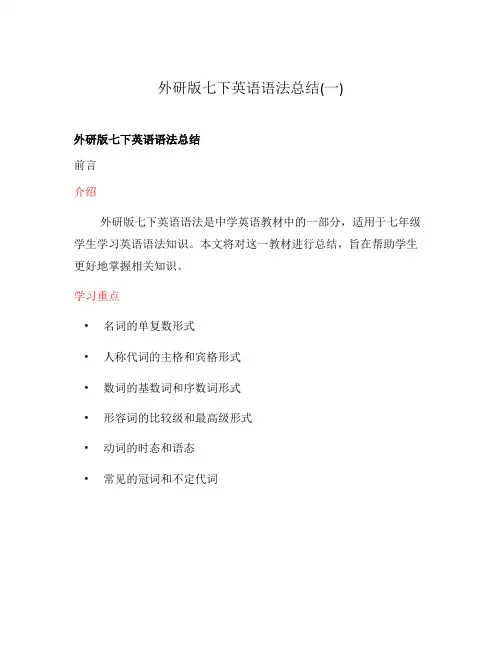
外研版七下英语语法总结(一)外研版七下英语语法总结前言介绍外研版七下英语语法是中学英语教材中的一部分,适用于七年级学生学习英语语法知识。
本文将对这一教材进行总结,旨在帮助学生更好地掌握相关知识。
学习重点•名词的单复数形式•人称代词的主格和宾格形式•数词的基数词和序数词形式•形容词的比较级和最高级形式•动词的时态和语态•常见的冠词和不定代词正文名词的单复数形式•名词的单数和复数形式有规律可循,如加-s和-es,或者变化整个词形等。
•需要注意的是,有些名词的复数形式是不规则的,需要特别记忆。
人称代词的主格和宾格形式•人称代词根据在句中的不同作用,分为主格和宾格形式。
•主格用于作主语,宾格用于作宾语或补语。
数词的基数词和序数词形式•基数词用来表示具体的数目,如one, two, ten等。
•序数词用来表示顺序,如first, second, tenth等。
形容词的比较级和最高级形式•形容词有比较级和最高级两种形式,用于描述事物的程度。
•通过在形容词后面加-er和-est,或者在前面加more和most来构成比较级和最高级。
动词的时态和语态•动词根据时间的不同,可以分为一般现在时、一般过去时和一般将来时等时态。
•动词的语态包括主动语态和被动语态,用于描述动作的执行者和承受者。
常见的冠词和不定代词•冠词包括定冠词和不定冠词,用于限定名词的范围。
•不定代词用来代替不确定的人或物,如somebody, anybody, something等。
结尾外研版七下英语语法是学生学习英语语法的重要教材之一。
通过对名词、人称代词、数词、形容词、动词和冠词等知识点的学习,学生可以更好地理解和运用英语语法规则。
希望本文的总结对学生的学习有所帮助。
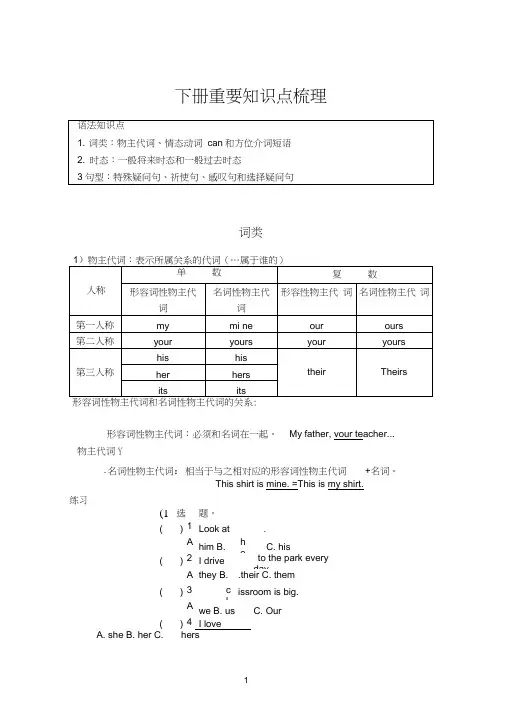
下册重要知识点梳理词类形容词性物主代词和名词性物主代词的关系:形容词性物主代词:必须和名词在一起。
My father, vour teacher... 物主代词Y-名词性物主代词:相当于与之相对应的形容词性物主代词+名词。
This shirt is mine. =This is my shirt.练习(1 )选择题。
( ) 1. Look at .A . him B.heC. his( ) 2. I drive to the park everydayA . they B. .their C. them( ) 3. clissroom is big.A . we B. us C. Our( ) 4. I loveA. sheB. herC. hers( )5. Do you know ?A. IB. myC. me( )6. I am son.A. theyB. theirC. them( )7. This is not desk.. My desk is over there.A. IB. myC. me( ) 8. —Can you spell n ame, Harry? —Sorry.A. youB.your <C. yours( )9. Tom and Jack are brothers. This is room.A. theyB. themC. their( )10. We are in the same class. classroom is very niceA. ourB. myC. ours( ) 11. Mrs. Green is my teacher. I ' m stude nt.A. heB. hisC. him( ) 12. That ' s a cat. n ame is Mimi.A. ItB. It 'sC. Its(2 ) 用括号里的代词的适当形式填空1, Mr Yang is ______ (we) teacher. _______ (him) is from Beiji ng. ______ (his) teaches _____ (our) En glish.2, Look,there is a cat. ______ (they) is Lily's. __ (it) n ame is Mimi.3, Let ____ (I) tell _____ (she) about _____ (he) life at school.4, This is _____ (they) room.Where is _____ (our)?5, Don't use the eraser. ____ is ______ (me).6, The lady un der the tree is _____ (me) aunt. ____ (her) ofte n sings with____ (she) husba nd2) 情态动词can1. 含义:表达人或物的能力,能或会…2. 特点:情态动词can没有人称和数的变化,之后要加动词原形。

初一下册英语语法大全外研版初一下册英语语法大全外研版Unit 1nbsp; Wheres your pen pal from?一.短语:1 .be from = come from 来自于----2. live in 居住在---3. on weekends 在周末4 .write to sb = write a letter to sb 给某人写信;写信给某人5 .in the world 在世界上in China 在中国6.pen pal 笔友14 years old 14岁favorite subject 最喜欢的科目7.the United States 美国the United Kingdom 英国New York 纽约8.speak English 讲英语like and dislike 爱憎9.go to the movies 去看电影play sports 做运动二.重点句式:1 Wherersquo;s your pen pal from? = Where does your pen pal from/2 Where does he live?3 What language(s) does he speak?4 I want a pen pal in China.5 I can speak English and a little French.6 Please write and tell me about yourself.7 Can you write to me soon?8 I like going to the movies with my friends and playing sports.三.本单元的国家,人民、语言对应。
1 Canada---- Canadian---- English / French2 France------ French------French3 Japan------Japanese----Japanese4 Australia----Australian----- English5 the United States------ American---- English6 the United Kingdom---British----- EnglishUnit 2 Wherersquo;s the post office?一. Asking ways: (问路)1. Where is (the nearest) hellip;hellip;? (最近的)hellip;hellip;在哪里?2. Can you tell me the way to hellip;hellip;? 你能告诉我去hellip;hellip;的路吗?3. How can I get to hellip;hellip;? 我怎样到达hellip;hellip;呢?4. Is there hellip;hellip; near here / in the neighborhood? 附近有hellip;hellip;吗?5. Which is the way to hellip;hellip;? 哪条是去hellip;hellip;的路?二.Showing the ways: (指路)1. Go straight down / along this street. 沿着这条街一直走。
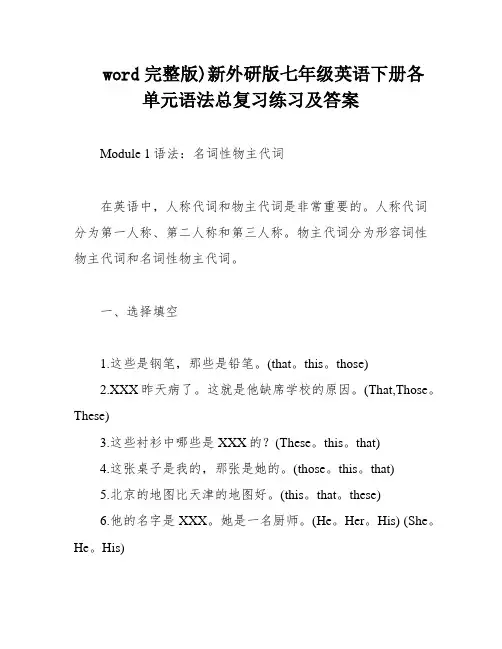
word完整版)新外研版七年级英语下册各单元语法总复习练习及答案Module 1语法:名词性物主代词在英语中,人称代词和物主代词是非常重要的。
人称代词分为第一人称、第二人称和第三人称。
物主代词分为形容词性物主代词和名词性物主代词。
一、选择填空1.这些是钢笔,那些是铅笔。
(that。
this。
those)2.XXX昨天病了。
这就是他缺席学校的原因。
(That,Those。
These)3.这些衬衫中哪些是XXX的?(These。
this。
that)4.这张桌子是我的,那张是她的。
(those。
this。
that)5.北京的地图比天津的地图好。
(this。
that。
these)6.他的名字是XXX。
她是一名厨师。
(He。
Her。
His) (She。
He。
His)7.我的姑妈是一名护士。
她工作非常努力。
(I,My,XXX) (She。
He。
Her)8.请给我指路。
(me。
I。
XXX)9.这些书不是我的。
它们可能是她的。
(my。
XXX。
I) (They。
It。
Its) (her。
hers。
your)10.让我告诉她如何做。
(I。
me。
mine) (her。
she。
hers)二、选择填空1.每个人都应该尽力而为。
(its。
ones。
his。
their)2.她是我的好朋友。
(She。
mine) (Her。
mine) (She。
my) (Hers。
my)1.What can you do。
I can lift this box。
but I can't lift that heavy chair.2.Can he read Chinese?——No。
he can't read Chinese。
but he can read.3.Can you stand in front of the door。
Then I can see you.4.Did XXX dishes。
Yes。
she did.5.I can see some spoons。
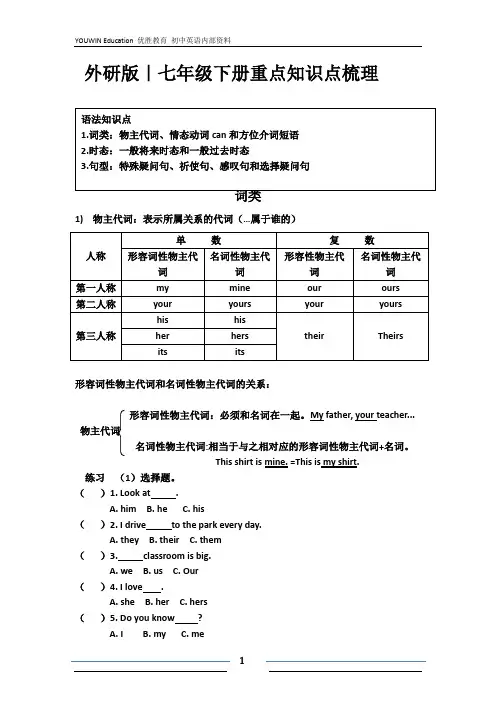
外研版|七年级下册重点知识点梳理1)物主代词:表示所属关系的代词(…属于谁的)形容词性物主代词和名词性物主代词的关系:形容词性物主代词:必须和名词在一起。
My father, your teacher... 物主代词名词性物主代词:相当于与之相对应的形容词性物主代词+名词。
This shirt is mine. =This is my shirt.练习(1)选择题。
()1. Look at .A. himB. heC. his()2. I drive to the park every day.A. theyB. theirC. them()3. classroom is big.A. weB. usC. Our()4. I love .A. sheB. herC. hers()5. Do you know ?A. IB. myC. me()6. I am son.A. theyB. theirC. them()7. This is not _____ desk.. My desk is over there.A. IB. myC. me()8. -Can you spell _____ name, Harry? -Sorry.A. youB. yourC. yours()9. Tom and Jack are brothers. This is _____ room.A. theyB. themC. their()10. We are in the same class. _____ classroom is very nice.A. ourB. myC. ours()11. Mrs. Green is my teacher. I’m _____ student.A. heB. hisC. him()12. That’s a cat. _____ name is Mimi.A. ItB. It’sC. Its(2)用括号里的代词的适当形式填空1, Mr Yang is _______(we) teacher.________(him) is from Beijing. _______(his) teaches______(our) English.2, Look,there is a cat._______(they) is Lily's.____(it) name is Mimi.3, Let______(I) tell ______(she) about_____(he) life at school.4, This is ______(they) room.Where is _____(our)?5, Don't use the eraser.______ is ______(me).6, The lady under the tree is ______(me) aunt._____(her) often sings with_____(she) husband2)情态动词can1.含义:表达人或物的能力,能或会…2.特点:情态动词can没有人称和数的变化,之后要加动词原形。
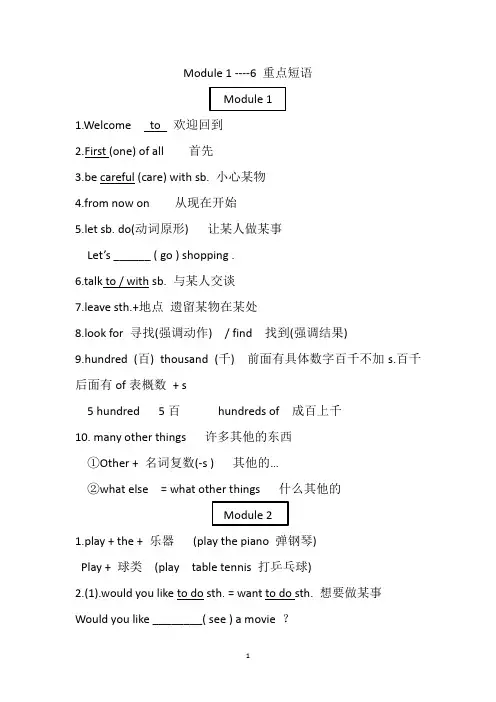
Module 1 ----6 重点短语Module 11.Welcome to 欢迎回到2.First (one) of all 首先3.be careful (care) with sb. 小心某物4.from now on 从现在开始5.let sb. do(动词原形) 让某人做某事Let’s ______ ( go ) shopping .6.talk to / with sb. 与某人交谈7.leave sth.+地点遗留某物在某处8.look for 寻找(强调动作) / find 找到(强调结果)9.hundred (百) thousand (千) 前面有具体数字百千不加s.百千后面有of表概数+ s5 hundred 5百hundreds of 成百上千10. many other things 许多其他的东西①Other + 名词复数(-s ) 其他的…②what else = what other things 什么其他的Module 21.play + the + 乐器(play the piano 弹钢琴)Play + 球类(play table tennis 打乒乓球)2.(1).would you like to do sth. = want to do sth. 想要做某事Would you like ________( see ) a movie ?(2).like doing sth. 喜欢做某事I like ________( see ) a movie .(3) enjoy doing sth. 喜欢做某事I enjoy ________( see ) a movie .(4). enjoy oneself 玩得开心enjoy myself 我玩得开心enjoy yourself 你玩得开心enjoy (herself/himself) 他/她玩得开心enjoy (yourselves/ourselves/themselves)你们/我们/他们玩得开心3.What about / how about + v.ing …怎么样?What about ________(see )a movie ?4.worry about (sb./sth. )担心某人/某物= be worried about (sb./ sth.)5.teach sb. sth. 叫某人某事Miss Suo teach _______( us / our ) English .6. get on well with sb. 与某人相处得好7.be good at doing sth. 擅长做某事= do well in doing sth. …做得好She is good at ______ (swim) .=______________________8. be ready to do sth. 准备做某事I am ready ______ ( go ) to school .9.promise to do sth. 许诺做某事I promise _______ (help) you .10.①help sb. ( to ) do sth. 帮助某人做某事We help our mother ______ (clean ) the rooms .②Help sb. with sth. 在某方面帮助某人11.make + v.原/ adj.形容词使…e with sb. 与某人一起来13.stay with sb. 与某人待在一起Module 31.be going to do sth. 打算做某事We are going to______ (have ) a picnic .2.look forward to doing sth. 期盼做某事I am look forward to _______ (see ) a movie .3. (1). spend (花费) 用法①sb.(某人) spend money/time on sth. 某人在某物上花费时间/钱②sb.(某人) spend money/time (in) doing sth.某人在某做某事上花费时间/钱(2) take (花费)①It take time to do sth. 做某事花费时间(3). Cost (花费/价值)Sth. cost sb. money 某物花费某人钱/某物值…钱(4). Pay for (支付)Sb. pay money for sth. 某人支付…钱为某物!练习:用spend/take / cost/pay 填空(1.) It __________ me ten hours to get Nanning .(2.) I _______ me ten hours getting Nanning .(3.) The pen ______ me 10 yuan .(4.) We need _______ 10 yuan for the pen .4.Watch sb. do sth. 看到某人做了某事(看了全过程)5.Watch sb. doing sth. 看到某人正在做某事(看到正在发生片段)5.feel lonely 觉得孤独/ live alone 独自生活6.make friends 交朋友7.It’s time to do sth. 到做某事的时间了= It’s time for doing sth.It’s time _______( go ) home .=_______________________Module 41.A be different from B A与B 不同2. A be the same as B A与B 相同3.There will be = there is / are going to be 将会有4.be able to = can 能5.not …anymore 不再6.not only A but also B 不但A 而且B ( 就近原则) Not only you but also I ______( be ) good at English .7.①A as well as B A还有B ( 用A做主语)You as well as I ______( be ) good at English .②as well =too 也e true 实现9.have sth. to do .有某事要做We have a lot of books ______ ( buy ) .10.in+一段时间表将来( in 20 years’time 再20年后)I _______ ( see ) a movie in two days .11.It’s + adj.(形容词) + to do sth. 做…是…的。
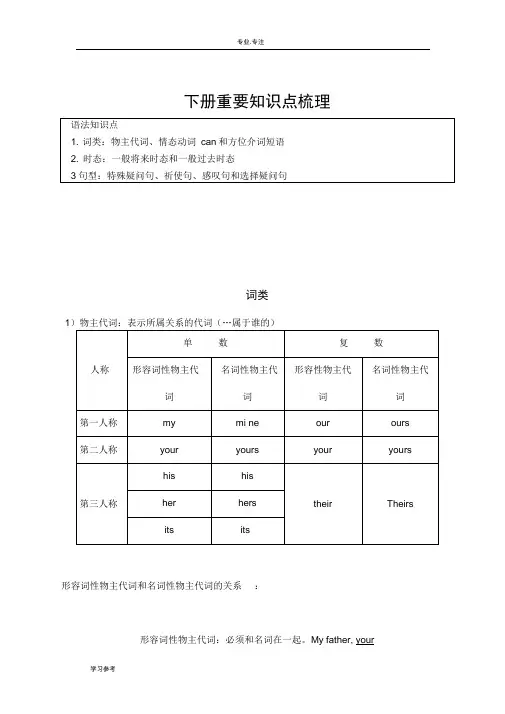
下册重要知识点梳理词类1形容词性物主代词和名词性物主代词的关系:形容词性物主代词:必须和名词在一起。
My father, yourteacher...物主代词+名词。
名词性物主代词:相当于与之相对应的形容词性物主代词This shirt is mine. =This is my shirt.练习(1)选择题。
()1. Look at ______ .A. himB. heC. his()2. I drive _____ tO the park every day.A. theyB. theirC. them()3. _____ assroom is big.A. weB. usC. Our()4. I love ____A. sheB. herC. hers()5. Do you know ______ ?A. IB. myC. me()6. I am _____ n.A. theyB. theirC. them()7. This is not ____ desk.. My desk is over there.A. IB. myC. me()8. —Can you spell _____ n ame, Harry? —Sorry.A. youB. yourC. yours( )9. Tom and Jack are brothers. This is _____ room.A. theyB. themC. their( )10. We are in the same class. _____ classroom is very ni ce.A. ourB. myC. ours( )11. Mrs. Green is my teacher. I ' m _____ student.A. heB. hisC. him( )12. That ' s a cat. _________ name is Mimi.A. ItB. It ' iC. Its(2)用括号里的代词的适当形式填空1, Mr Yang is ______ (we) teacher. ______ (him) is from Beiji ng. _______ (his) teaches _____ (our) En glish.2, Look,there is a cat. _____ (they) is Lily's. ___ (it) n ame is Mimi.3, Let _____ (I) tell ______ (she) about ____ (he) life at school.4, This is _____ (they) room.Where is ____ (our)?5, Don't use the eraser. ____ is ______ (me).6, The lady un der the tree is_____ (me) aunt. ____ (her) ofte n sings with____ (she) husba nd2) 情态动词can1. 含义:表达人或物的能力,能或会…2. 特点:情态动词can没有人称和数的变化,之后要加动词原形。
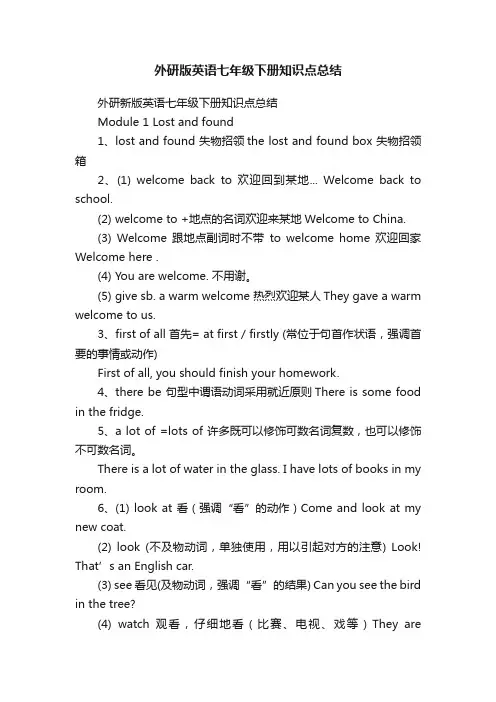
外研版英语七年级下册知识点总结外研新版英语七年级下册知识点总结Module 1 Lost and found1、lost and found 失物招领the lost and found box 失物招领箱2、(1) welcome back to 欢迎回到某地... Welcome back to school.(2) welcome to +地点的名词欢迎来某地Welcome to China.(3) Welcome 跟地点副词时不带to welcome home 欢迎回家Welcome here .(4) You are welcome. 不用谢。
(5) give sb. a warm welcome 热烈欢迎某人They gave a warm welcome to us.3、first of all 首先= at first / firstly (常位于句首作状语,强调首要的事情或动作)First of all, you should finish your homework.4、there be 句型中谓语动词采用就近原则There is some food in the fridge.5、a lot of =lots of 许多既可以修饰可数名词复数,也可以修饰不可数名词。
There is a lot of water in the glass. I have lots of books in my room.6、(1) look at 看(强调“看”的动作)Come and look at my new coat.(2) look (不及物动词,单独使用,用以引起对方的注意) Look! That’s an English car.(3) see 看见(及物动词,强调“看”的结果) Can you see the bird in the tree?(4) watch 观看,仔细地看(比赛、电视、戏等)They arewatching TV now.(5) read 看(书、报纸、杂志等) My mother is reading a book /a magazine /a newspaper.7、everyone/everybody 做主语,谓语动词用单数形式。
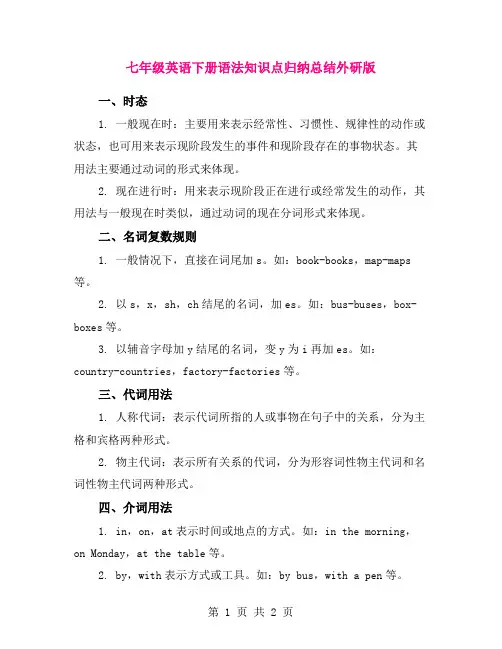
七年级英语下册语法知识点归纳总结外研版一、时态1. 一般现在时:主要用来表示经常性、习惯性、规律性的动作或状态,也可用来表示现阶段发生的事件和现阶段存在的事物状态。
其用法主要通过动词的形式来体现。
2. 现在进行时:用来表示现阶段正在进行或经常发生的动作,其用法与一般现在时类似,通过动词的现在分词形式来体现。
二、名词复数规则1. 一般情况下,直接在词尾加s。
如:book-books,map-maps 等。
2. 以s,x,sh,ch结尾的名词,加es。
如:bus-buses,box-boxes等。
3. 以辅音字母加y结尾的名词,变y为i再加es。
如:country-countries,factory-factories等。
三、代词用法1. 人称代词:表示代词所指的人或事物在句子中的关系,分为主格和宾格两种形式。
2. 物主代词:表示所有关系的代词,分为形容词性物主代词和名词性物主代词两种形式。
四、介词用法1. in,on,at表示时间或地点的方式。
如:in the morning,on Monday,at the table等。
2. by,with表示方式或工具。
如:by bus,with a pen等。
五、形容词比较等级用法1. 比较级:表示两者之间的比较,通过比较级后缀-er或连词than来体现。
2. 最高级:表示三者或三者以上之间的比较,通过最高级后缀-est或副词very,most来体现。
六、一般疑问句及回答一般疑问句是将疑问句以系动词be或助动词do及其时态形式提出,并用简短的肯定或否定回答。
通常用yes或no来回答。
以上就是七年级英语下册语法知识点归纳总结外研版的主要内容,希望对学生们的学习有所帮助。
完整)外研版七年级下册英语语法专题复习(含练习)YOUWIN n的初中英语内部资料为外研版七年级下册的重点知识点梳理。
以下是该资料中的语法知识点。
1.词类:物主代词、情态动词can和方位介词短语。
2.时态:一般将来时态和一般过去时态。
3.句型:特殊疑问句、祈使句、感叹句和选择疑问句。
在物主代词方面,单数包括第一人称、第二人称和第三人称。
形容词性物主代词必须和名词在一起,如my father、your teacher。
名词性物主代词相当于与之相对应的形容词性物主代词和名词的组合,如this shirt is mine,相当于this is my shirt。
在复数方面,形容性物主代词包括our、your和their,名词性物主代词包括ours、yours和theirs。
而词类方面,包括mine、yours、his、hers和its,形容词性物主代词包括my、your、his、her和its。
练题包括选择题和填空题,以检验学生对物主代词的掌握程度。
11.Mrs。
Green is my teacher。
I am her student.12.That's a cat。
Its name is Mimi.1.Mr。
Yang is our teacher。
He is from Beijing。
He teaches us English.2.Look。
there is a cat。
It is Lily's。
Its name is Mimi.3.Let me tell her about my life at school.4.This is their room。
Where is ours?5.Don't use the eraser。
It is mine.6.The lady under the tree is my aunt。
She often sings with her husband.Can is a modal verb that expresses ability or possibility。
一、选择题1.I have bought a Chinese – English dictionary. When and where_____ you _____ it? A.have, bought B.did buy C.will, buy D.do , buy B解析:B【解析】【分析】【详解】句意:——我已经买了一本英汉字典。
——你什么时间在哪里买的字典?考查过去时态的用法。
根据句意可知是询问过去的事情,所以用一般过去时态,故选B。
2.The woman made her husband_______ outside the gate yesterday afternoon.A.wait B.waiting C.to wait D.waited A解析:A【解析】【详解】句意:昨天下午那个女人让她的丈夫在门外等待。
考查非谓语动词。
wait动词原形;waiting动名词或现在分词形式;to wait动词不定式;waited过去分词。
make是使役动词,后接不带to的不定式作宾语补足语,make sb. do sth.让某人做某事,故选A。
3.—Listen! I can hear someone __________ for help.—Is there __________?A.calling; anything wrong B.call; anything wrongC.calling; wrong anything D.call; wrong anything A解析:A【解析】【详解】句意:——听!我听见有人在呼救。
——有什么不对劲吗?考查感官动词和形容词做定语修饰不定代词的用法。
听到某人干某事hear sb do/doing sth;根据句中Listen!听的提示,说明听到的动作正在进行,所以感官动词hear应用hear sb doing sth结构,故排除B、D项;当有形容词wrong修饰不定代词anything时,形容词必须后置,故排除C项,故选A。
七年级下册英语语法总复习初一下册我们学习了:一般现在时,现在进行时,一般将来时,一般过去时,形容词的比较级和最高级,一:一般现在时:功能 1.表示事物或人物的特征、状态。
如:The sky is blue.天空是蓝色的。
2.表示经常性或习惯性的动作。
如:I get up at six every day.我每天六点起床。
3.表示客观现实。
如:The earth goes round the sun.地球绕着太阳转。
一般现在时的构成1. be动词:主语 be(am,is,are) 其它。
如:I am a boy.我是一个男孩。
2.行为动词:主语行为动词( 其它)。
如:We study English.我们学习英语。
当主语为第三人称单数(he, she, it)时,要在动词后加"-s"或"-es"。
如:Mary likes Chinese.玛丽喜欢汉语。
一般现在时的变化1. be动词的变化。
否定句:主语 be not 其它(be动词后 not)如:He is not worker.他不是工人。
一般疑问句:Be 主语其它。
(be动词放句首)如:Are you student? -Yes. I am. / No, I'm not.特殊疑问句:疑问词一般疑问句。
如:Where is my bike?(疑问词)(一般疑问句)2.行为动词的变化。
否定句:主语 don't( doesn't ) 动词原形( 其它)。
如:I don't like bred.当主语为第三人称单数时,要用doesn't构成否定句。
如:He doesn't often ply. 一般疑问句:Do( Does ) 主语动词原形其它。
如:- Do you often ply football?- Yes, I do. / No, I don't. 当主语为第三人称单数时,要用does构成一般疑问句。
七年级英语下册语法知识点归纳总结外研版摘要:1.概述2.七年级英语下册语法知识点归纳总结1.1 名词1.2 冠词1.3 代词1.4 形容词1.5 副词1.6 动词1.7 介词1.8 连词1.9 感叹词1.10 疑问词3.外研版七年级英语下册语法知识点的优势4.总结正文:作为一名中文知识类写作助理,根据所提供的文本,我将为您编写一篇关于七年级英语下册语法知识点归纳总结外研版的文章。
【概述】在初中英语学习中,七年级是一个关键时期,此时学生需要掌握一定的语法知识,为以后的英语学习打下坚实的基础。
外研版七年级英语下册教材对语法知识点进行了全面、系统的归纳总结,为广大学生提供了便利的学习工具。
本文将针对外研版七年级英语下册语法知识点进行归纳总结,帮助学生更好地掌握这些知识点。
【七年级英语下册语法知识点归纳总结】1.1 名词:名词分为可数名词和不可数名词,可数名词有单数和复数形式,不可数名词没有复数形式。
1.2 冠词:冠词分为定冠词和不定冠词,定冠词表示特指,不定冠词表示泛指。
1.3 代词:代词分为人称代词、物主代词、指示代词和疑问代词,用于替代名词、形容词和动词。
1.4 形容词:形容词用于修饰名词,分为原级、比较级和最高级。
1.5 副词:副词用于修饰动词、形容词、其他副词或整个句子,表示程度、方式、地点、时间等。
1.6 动词:动词分为及物动词和不及物动词,根据时态、语态和语气的不同,动词形式也会有所变化。
1.7 介词:介词用于表示名词、代词和动词与其他词的关系,或者表示动作的地点、时间、方向等。
1.8 连词:连词用于连接词、短语或句子,分为并列连词和从属连词。
1.9 感叹词:感叹词用于表示喜怒哀乐等情感,如oh、ah、oh no 等。
1.10 疑问词:疑问词用于构成疑问句,如what、where、when、why 等。
【外研版七年级英语下册语法知识点的优势】外研版七年级英语下册语法知识点具有以下优势:1.系统性强:外研版教材对语法知识点进行了全面、系统的归纳总结,有利于学生更好地理解和掌握。
下册重要知识点梳理词类1)物主代词:表示所属关系的代词(…属于谁的)形容词性物主代词和名词性物主代词的关系:形容词性物主代词:必须和名词在一起。
My father, your teacher... 物主代词名词性物主代词:相当于与之相对应的形容词性物主代词+名词。
This shirt is mine. =This is my shirt.练习(1)选择题。
()1. Look at .A. himB. heC. his()2. I drive to the park every day.A. theyB. theirC. them()3. classroom is big.A. weB. usC. Our()4. I love .A. sheB. herC. hers()5. Do you know ?A. IB. myC. me()6. I am son.A. theyB. theirC. them()7. This is not _____ desk.. My desk is over there.A. IB. myC. me()8. -Can you spell _____ name, Harry? -Sorry.A. youB. yourC. yours()9. Tom and Jack are brothers. This is _____ room.A. theyB. themC. their()10. We are in the same class. _____ classroom is very nice.A. ourB. myC. ours()11. Mrs. Green is my teacher. I’m _____ student.A. heB. hisC. him()12. That’s a cat. _____ name is Mimi.A. ItB. It’sC. Its(2)用括号里的代词的适当形式填空1, Mr Yang is _______(we) teacher.________(him) is from Beijing. _______(his) teaches______(our) English.2, Look,there is a cat._______(they) is Lily's.____(it) name is Mimi.3, Let______(I) tell ______(she) about_____(he) life at school.4, This is ______(they) room.Where is _____(our)?5, Don't use the eraser.______ is ______(me).6, The lady under the tree is ______(me) aunt._____(her) often sings with_____(she) husband2)情态动词can1.含义:表达人或物的能力,能或会…2.特点:情态动词can没有人称和数的变化,之后要加动词原形。
3.否定形式:cannot(正式用法)=can’t(口语)4.句型结构:肯定句:主语+ 情态动词+ 动词原形+ 其他+ 。
She / They can swim well.否定句:主语+ 情态动词+ not + 动词原形+ 其他+ 。
She / They can not swim well.一般疑问句:情态动词+ 主语+ 动词原形+ 其他+ ?Can she / they swim well?Yes, she / they can. / No, she / they can’t.特殊疑问句:疑问词+ 情态动词+ 主语+ 动词原形+ 其他+ ?Why can she / they swim well?Who can swim well?练习:( ) 1) The sign on the wall means you stay away from the building.A. mustB. can’tC. shouldn't( ) 2) How many books you see on the desk?A. mayB. canC. should( )3) --- you see the sign over there? --- Sorry, I can’t.A. CanB. Can’tC. Should4. I can run fast. I ________ ________ fast. (否定句)5. He can play basketball well. (一般疑问句)_______ he ______ basketball well?3)介词over在……between ...and ...在两者之间Lingling sits between Tony and Daming. 玲玲坐在托尼和大明之间among 在三者或三者以上之间Miss Li is among lots of students. 李老师在许多同学之间注意:介词短语常和be动词连用。
时态1)一般将来时时间状语:in+一段时间;tomorrow;in the future; next+时间;this+时间(表示将来时间的状语)﹙Ⅰ﹚be(is,am.are)going to 的用法。
含义:计划,打算做某事将来时句型结构:一般将来时be going to+动词原形肯定句结构:主语+be going to +动词原形+其他.否定句结构:主语+be not going to +动词原形+其他.一般疑问句:be动词提前Be +主语+going to +动词原形+其他?肯定回答:Yes,主语+be.否定回答:No,主语+be not.注意:①表示计划到某地去,谓语动词go与going重复,一般只说be going to +地点.②come/go/arrive/leave等表示位置转移的动词可用于现在进行表将来。
Eg:I am going to London next year.She is going to check her email.Look! The bus is coming.﹙Ⅱ﹚由shall和will引导的一般将来时含义:将会…特点:助动词shall和will没有人称和数的变化,之后要加动词原形。
shall在一般将来时中,一般用于第一人称之后。
例如:I/We shall have an English lesson.我们将有一节英语课。
否定形式:shall not=shan′t will not=won′t将来时句型结构:肯定句:主语+shall/will+do否定句:主语+shall/will+not+do(will not 可缩写成won’t)一般疑问句:shall/will+主语+ do特殊疑问句:疑问词+ shall/will+主语+do2)一般过去时1.一般过去时表示过去某个时间发生的动作或存在的状态,常和表示过去的时间状语连用。
一般过去时也表示过去经常或反复发生的动作。
2.标志性时间状语:yesterday(昨天), last week(上周), last month(上个月), last year(去年), two months ago(两个月前), the day before yesterday (前天),in 1990 (在1990年), in those days (在那些日子里)等表示过去的时间状语连用。
3.动词结构:V-ed动词过去式变化规则:1.一般在动词末尾加-ed,如:pull-pulled, cook-cooked2.结尾是e加d,如:taste-tasted3.末尾是辅音字母加一个元音字母和一个辅音字母的重读闭音节,应双写末尾的辅音字母,再加-ed,如:stop-stopped4.以“辅音字母+y”结尾的,变y为i,再加-ed,如:study-studied5.不规则动词过去式:lose(丢失) ----lostmake(制造) ----made mean(意思) ----meant meet(见) ----metpay(付) ----paidsay(说) ----saidsell(卖) ----sold send(送)----sentsit(坐) ----satsleep(睡) ----slept smell(嗅) ----smelt spell(拼写) ----spelt spend(度过) ----spent stand(站) ----stood teach(教) ----taught tell(告诉) ----toldwin(赢) ----wonthink(想) ----thoughtunderstand(理解) ----understood begin(开始) ----beganblow(吹) ----blewbreak(打破) ----brokechoose(选择) ----chosedo(做) ----diddraw(画) ----drewdrink(喝) ----drankdrive(驾驶) ----droveeat(吃) ----atefall(落下) ----fellfly(飞) ----flewforget(忘) ----forgotgive(给) ----gavego(去) ----wentgrow(成长) ----grewknow(知道) ----knewlie(躺) ----lay----lainring(按铃) ----rangwrite(写) ----wroteride(骑) ----rodesee(看见)----sawshow(出示) ----showed wake(弄醒) ----wokesing(唱) ----sangspeak(讲话) ----spoke steal(偷) ----stole wear(穿) ----woreswim(泳) ----swamtake(拿) ----tookthrow(扔) ----threw become(成为) ----became come(来) ----camerun(跑) ----ran4. 句式变化规则:Be动词在一般过去时中的变化:(1)am 和is在一般过去时中变为was。
(was not=wasn't)(2)are在一般过去时中变为were。
(were not=weren't)(3)带有was或were的句子,其否定、疑问的变化和is, am, are一样,即否定句在was或were后加not,一般疑问句把was或were调到句首。